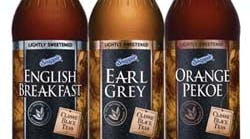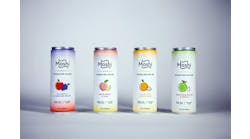Tea trails only water as the most consumed beverage in the world. Iced tea is particularly hot in the U.S., with us drinking 80 percent of all iced tea produced. Tea, both hot and cold, has been increasing in popularity for at least the past 10 years.
Besides its taste and thirst-quenching properties, tea is consumed for health benefits, such as antioxidants from the beverage's high levels of flavonoids. The increased number of iced tea offerings at coffeehouse chains further emphasizes the rise in tea drinking popularity - according to NPD Group, servings of iced tea in restaurants have increased 12.5 percent since 2001.
Fruit-flavored teas are regaining popularity in both freshly brewed versions and bottled varieties, followed closely by "sweet tea," a Southern favorite. Another recent trend in iced tea is in organics and varietals, which tie in well with the overall beverage category trend toward "freshness" and "premiumness".
As we reported last year when Pom Wonderful introduced a ready-to-drink (RTD) tea, the RTD market for iced tea represents one of the largest segments for tea, with more than $700 million in sales, according to 2005 IRI figures.
Trends in one category often present innovations in another. Starbucks created interest in specific types of coffee beans, just as the classic hot tea people had done years before. Why not keep the circle going with the use of specific varietals of black tea for RTD tea? This would help the consumer understand the purpose of the new tea and what to expect in a more distinctive, darker flavor.
Snapple, which is owned by Cadbury Schweppes, faces some well-funded competition in this category with the likes of Lipton (a partnership between Unilever and PepsiCo) and Nestea (a partnership between Nestle and Coca-Cola), as well as smaller yet relevant brands like Arizona and Republic of Tea. So the idea of building upon models like Starbucks and classic hot tea become enticing. Why not present the consumer with varietals of black tea that have distinctive tastes (not necessarily the case with green, red and white teas) and suggest the product be used in other parts of the day?
Insights
Based on our Drink It! Insight, we find cold teas are chosen based on taste, aroma and beverage temperature. They are refreshing because they are icy cold, not too sweet and have well-blended flavors. Teas are of the brown beverage group (coffee, tea and cola), which is the reference point for all beverages. They are consumed across all day parts, but can be found most often at lunch, in the afternoon and with dinner.
The Drink It! data also suggest RTD tea is not about the bitter aftertaste often associated with hot tea or instant iced teas, yet may have a sweet/bitter after-flavor. RTD tea flavors that consumers are looking for are fruity, berry flavors, not a creamy or traditional flavor.
Tea is a beverage that goes with TV watching and playing on computers. It's thought of as a natural beverage, like water. It fits our lives today. It also provides a form of health insurance, of potential health benefits, but consumers want these health benefits to be naturally occurring. Tea is an emotional experience with consumers looking for "cool" and "inviting" and "relaxes you after a busy day."
While flavor and calorie-level variations have been the path forward for most beverages in recent years, consumers will accept only so many line extensions; then they begin to look for alternatives in either traditional beverages or more premium beverages. English Breakfast, Orange Pekoe and Earl Grey are all names we know from hot tea. What might that do to our thinking about RTD tea?
The experience
Snapple Classic Black Teas are available in shrink-wrapped, 17.5-oz. glass bottles in three varieties: English Breakfast, Earl Grey and Orange Pekoe. The price is $1-1.50 per bottle. Graphics on the bottle are more subdued, clean, even somewhat "old world" compared to the rest of Snapple's lineup. The Snapple logo is small in comparison to other Snapple varieties.
Everything about the label speaks "tea" rather than the fun, fruity, juice cocktails we associate with Snapple. The tea itself looks more "real" than other RTD varieties. English Breakfast is labeled "lightly sweetened," which some tasters thought was a nice change of pace from the typical, rather syrupy taste of classic RTD teas. The sweetener was pleasant, not overly sweet, and it complemented the taste of the tea, which folks believed was familiar English Breakfast. The presence of a slight honey note was appreciated, but what was also noted was the absence of a strong lemon flavor ("the kind that reminds you of dish soap," one of our consumer tasters commented) that many RTD teas posses.
Our tasters said the tea was "well formulated." Some even heated the tea in the glass bottle with the metal lid removed to see if they could use it as hot tea to go. Some folks wondered when they would drink English Breakfast tea. At breakfast? That was a far cry from their usual consumption of Snapple beverages, but probably not the target for this product anyway.
A full bottle of the tea has about 90 calories, while a cup (8 oz.) comes in at 40. The ingredients and the label statement are simple and appealing.
Does the product deliver?
Snapple has been about quirky RTD teas in a large variety of flavors in both sugared and diet versions. Snapple English Breakfast Tea is more serious and promises an authentic tea experience. The simple ingredients of tea, sugar and honey are very reassuring to those who look for real taste.
While Snapple is striving to market to serious tea drinkers by offering varietals, they may confuse some since the product is neither classic RTD nor freshly brewed. After tasting the tea icy cold, which can also be served warm as traditional English Breakfast would, RTD tasters said, "It tastes too much like real brewed tea," while freshly brewed iced tea drinkers felt like it still had "that taste" that all RTD teas seem to have. "That taste" being one of iced tea that was made yesterday and left on the counter by mistake overnight.
However, the same consumers felt it would be a better alternative thirst quencher (not bubbly like soda) to all the other RTD teas on the market. They just wouldn't go out of their way to buy it on a regular basis.
How to make the idea bigger: The idea of having brewed tea you can consume cold or hot is a good idea in this fast-paced world. For those who would enjoy real brewed tea but just do not want to go though the hassle of brewing, this hits a spot.
We are not sure what is motivating us, but we see a large container you could store in your refrigerator. If the idea grows, making a range of these varietals that could be used in multiple uses (hot, cold, in "punchbowl" recipes) seems to be a way to reframe the traditional thoughts of RTD and move it into other use occasions.
Rating: The product does deliver on the promise of a different kind of black tea. It may be a disconnect for the loyal Snapple customer and may not be thought about by regular tea consumers, but Snapple has captured the essence of English Breakfast tea in a bottle.
Market potential: OK, but it will not appeal to all. And it may not quickly reach the audience Snapple wants. Other processors will take the idea and work it into their products.
Hollis Ashman, Jacqueline Beckley and Jennifer Maca are principals of the Understanding & Insight Group, a strategy and product development firm that connects with consumers using qualitative and quantitative approaches. See www.theuandigroup.com.

